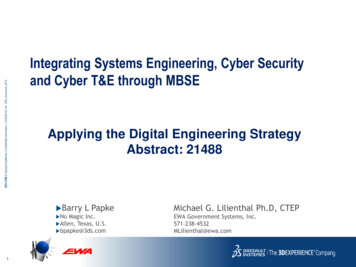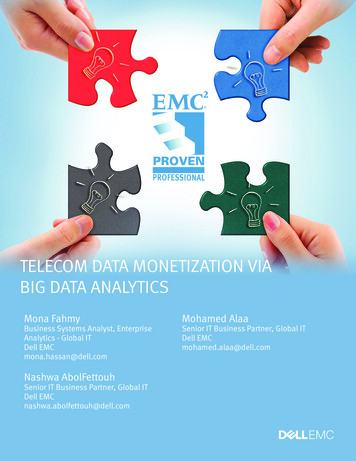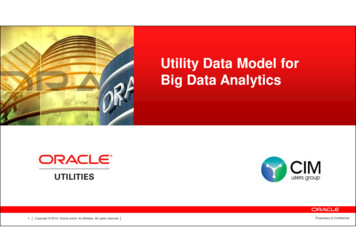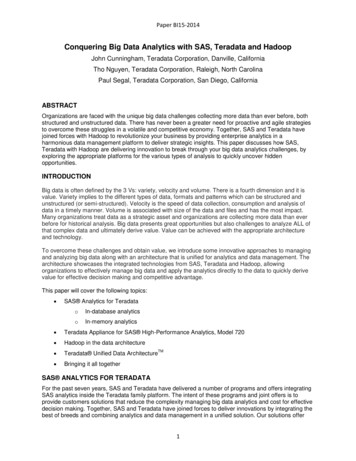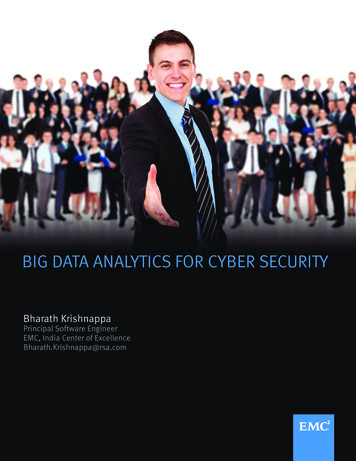
Transcription
BIG DATA ANALYTICS FOR CYBER SECURITYBharath KrishnappaPrincipal Software EngineerEMC, India Center of ExcellenceBharath.Krishnappa@rsa.com
Table of ContentsIntroduction . 2Big Data Analytics . 4Security . 4Intrusion detection . 5Remote Banking Fraud detection . 6Monitoring, Breach investigation, and Incident response . 7Usability and convenience . 9Challenges . 9Privacy .10Security controls in big data tools .12Data Authenticity and Integrity .12Conclusion .13References .14Disclaimer: The views, processes or methodologies published in this article are those of theauthors. They do not necessarily reflect EMC Corporation’s views, processes or methodologies.2015 EMC Proven Professional Knowledge Sharing2
IntroductionAccording to a 2011 EMC-sponsored IDC study "Extracting Value from Chaos”, it was estimatedthat 1.8 zettabytes will be created in 2011 and the world’s information will double every year. Azettabyte is roughly 1000 exabytes. To place that volume in more practical terms, an exabytealone has the capacity to hold over 36,000 years’ worth of HD quality video or stream theentire Netflix catalog more than 3,000 times [Cisco Blog]. Overwhelming, isn’t it?Today, only a fraction of this data is used to aid business decisions. Big data analytics is set tochange this. Its goal is to bring more and more data into play. Many organizations and bigbusinesses have woken up to the potential of big data and machine learning. Almost all of themare either exploring ways to put them to use or are already using them. Big data has been oneof the top trending topics in Information Technology for some time now and I believe it willcontinue to be on top for a long time.Cyber security is an ever evolving field. Every new technology will introduce a new set of threatsand vulnerabilities, making security a moving target. What makes it worse is the fact thatsecurity is almost always an afterthought when it comes to new technologies. According to anews release from Ernst & Young - “Global companies in a hurry to adopt new technologies andmedia, leaving threats to security as an afterthought”.Considering the dynamic nature of the security domain, big data analytics can play a major rolein areas such as malware detection, intrusion detection, multi-factor authentication, etc. Mostorganizations today tend to over-compensate with techniques such as multi-factorauthentication to protect themselves and their customers. Security almost always trades-offusability. If not moreso, usability is almost as important as security for some verticals likeecommerce. For an ecommerce site each extra step or extra second required to complete atransaction will negatively impact revenue. Big data and machine learning techniques can beemployed to assess risk by collecting and analyzing various contributing factors such as IPaddress, device type, device location, browser, MAC address, ISP, user history, etc. Only if therisk is high will additional security measures be enforced. This way, usability will be impactedonly for a few transactions that are deemed risky. This article documents and discusses suchexamples where big data analytics techniques can be used to tackle some of the difficultsecurity challenges like Advanced Persistent Threat (APT), big ticket breaches plaguing bothprivate and public sectors today.2015 EMC Proven Professional Knowledge Sharing3
Big Data AnalyticsThis is how Gartner defines big data - “Big data is high-volume, high-velocity and high-varietyinformation assets that demand cost-effective, innovative forms of information processing forenhanced insight and decision making.” There are plenty of definitions out there for big data butGartner’s definition made best sense to me. One notable omission in this definition isvisualization. The reason I feel visualization is important is that the collection of data alwaysoutpaces our ability to derive value from it. This is due to limited availability of actionableinsights. However, with the aid of visual analytics, the structures and patterns in the data can beanalyzed and actionable insights can be derived at a rapid pace [Ngrain article].Most techniques like machine learning, statistics, predictive analysis, behavioral analysis, etc.used today for big data analytics have been there for a long time. Traditionally, these techniqueswere used on structured data sets ranging from a few MBs to a few GBs. Today they canhandle bigger volumes, up to petabytes of both structured and unstructured data. Drivers for thisrapid change are: Hadoop and tools built around Hadoop that can handle all three Vs of big data; volume,velocity and variety. NoSQL databases that can store massive amounts of data and retrieve them atbreakneck speed. Decreasing cost of storage and compute. Cloud computing technologies that enable easy and elastic access to massive amountsof compute, storage, and network.SecurityAnalytics is not new to the world of security. If you think about it, intrusion and fraud detectionsystems have been using analytics for a long time. But these traditional systems employanalytics in a limited way. They collect very limited data due to storage or relational database management system(RDBMS) restrictions. Data is deleted after a fixed retention period because of storage or RDBMS capacity orperformance restrictions. The amount of processing involved for decision making is also limited since they areexpected to be non-intrusive and add limited overhead.2015 EMC Proven Professional Knowledge Sharing4
To meet non-intrusive (high tps, low response time) requirements, these expensivetechniques are employed as periodic offline process, delaying detection. Needless toexplain the cost of delays in detecting fraud and intrusion. They can handle only structured data.If you look at the limitations of these traditional systems and the reasons for the restrictions, therestrictions seem artificial when you factor in big data technologies. Hadoop and NoSQLdatabases can: be deployed on commodity hardware and handle massive amounts of data scale horizontally; as and when the data size increases, more nodes can be addedseamlessly run complex processes on massive amounts of data at unprecedented speeds.Add real time stream processing to the mix and we can build systems with limitless capabilities.In this section, we discuss some of the limitations of the traditional security solutions and howbig data tools can be utilized to alleviate them.Intrusion detectionIntrusion detection systems (IDSs) monitor network, network node, or host traffic and flag anyintrusions. IDS use either statistical anomaly-based technique or signature-based technique forintrusion detection.Signature-based techniques monitors and compares the network packets and traffic patternsagainst a set of signatures created from known threats and exploits. Big data tools may not adda lot of value for this technique except that they can improve the pattern matching speeds andincrease the capacity of signature databases.On the other hand, statistical anomaly-based detection technique compares the network trafficwith the baseline and flags major deviations from the baseline as intrusion. In my opinion, this isthe better technique compared to signature-based technique for the simple reason that it isadaptive. Here big data tools can play a huge role. It can facilitate collection and extendedretention of more data per network packet and also the traffic pattern and monitoringinformation. This anomaly-based technique is as good as the baseline with which it compares.If the baseline has to be effective, it has to be dynamic and contextual. The baseline can differ2015 EMC Proven Professional Knowledge Sharing5
based on the time, events, etc. Below are a few examples to demonstrate the contextual natureof baseline. In organizations operational mostly during the day, network traffic is less at night. Traffic to the ACH handling module increases during the time of day when ACHtransactions are processed. There should be no network traffic in the daytime from the laptop belonging to the userwho works the night shift. Traffic to a bank on the last day of the month can surge when salaries get credited.Most of the information required to build the contextual baseline like employee shift timings,ACH processing window, etc. are already available in different systems but they are notleveraged yet. Big data techniques like real time stream processing can leverage data collectedfrom such disparate sources and build contextual baselines at great speed. Add some guided orsemi-guided learning techniques to the mix and utility of the IDS will improve significantly. It canreduce the false alarm rates that plague them today and even when there are false alarms, itcan learn some specifics from the analyst and use that to fine tune the baseline. It can easilycombat IDS evasion techniques like low bandwidth attacks, fragmentation, etc.Remote Banking Fraud detectionBanks have a very difficult task of balancing between fraud detection overheads and the everincreasing need for faster payments. Since faster payments translate to instant revenues, italmost always trumps fraud detection. Due to this, the fraud detection solutions in this spacehave to be very accurate. Tolerance for false positives is very low. A list of factors that can helpdetermine frauds accurately are: User-to-device mapping – Maintain a list of devices user employ to access their account. Device profile – If the device is a public access computer, no anti-virus protection, etc. Source IP address – Is the IP blacklisted or is it a proxy IP? Location of access – i.e. if the access is from countries like Nigeria User behavior – time of day, last access location Payee profile – is the payee of a transfer known to have previously benefited from fraud? User’s risk appetite – Credit rating, casino statistics, traffic violations, law violationhistory. The thought behind listing them as factors is that a risky transaction from aperson who is accustomed to taking risks may not really be a fraudulent transaction.2015 EMC Proven Professional Knowledge Sharing6
User’s profession and education levels – A security professional is less likely to open aphishing email compared to a fashion model. Does the user have a history of substance abuse? –irrational choices can be madewhen under the influence of substances. Is the user a public figure? – high value target. User’s travel itinerary from travel sites.I was letting my imagination run amok; some of these facts cannot be collected in a secure andtrustworthy fashion. Other facts are out of bounds for the banks due to laws and regulations.However, suppose there is a framework for organizations to share data about the users anddevices. Imagine how much the following examples can contribute to the accuracy of frauddetection: a user’s travel itinerary from travel sites like Agoda and Expedia type of sites that user frequents that Facebook and Google tracks, devices on which anti-virus products are installed from the anti-virus vendorsSolutions available in this space today already use some of these factors. But when it comes tocollecting more data, they are limited by capacity constraints of the traditional technologies.Even the data retention intervals are short due to capacity constraints. In these solutions,building of profiles is handled by offline scheduled tasks to limit the overhead of fraud detectionbut this increases the time to value of the data. An analyst’s turnaround time is typically on thehigher side because mining for the required data is a slow and tedious process. NoSQLdatabases can alleviate capacity constraints to a large extent and It ease the pain of datamining for fraud analysis. Tools like Storm that offer distributed real time computationcapabilities can be used to build the profiles quickly and on the fly to reduce the time to value ofdata. Big data visual analytics aids for fraud analysts can help them derive new actionableinsights and push them into the system.Monitoring, Breach investigation, and Incident responseAn RSA white paper – Intelligence Driven Threat Detection & Response – explains thelimitations of the traditional monitoring techniques very well - “Faced with constant streams ofdata moving over the network, the temptation—and until recently, the only option—has been tofocus data collection and analytics on select problem areas. Security teams often collect andanalyze logs from critical systems, but this log-oriented approach to threat detection leaves2015 EMC Proven Professional Knowledge Sharing7
many blind spots that sophisticated adversaries can exploit.” The traditional techniques alsorelied heavily on signature-based detection and black listing. These techniques can bebypassed and when they are it takes significant time to block the new attack vector becausethese techniques are by nature, static.The traditional techniques are also weak at identifying sophisticated attacks like APT andsteganography.APT - CSA’s “Big Data Analytics for Security Intelligence” paper defines APT as “An AdvancedPersistent Threat (APT) is a targeted attack against a high-value asset or a physical system. Incontrast to mass-spreading malware, such as worms, viruses, and Trojans, APT attackersoperate in “low-and-slow” mode. “Low mode” maintains a low profile in the networks and “slowmode” allows for long execution time. APT attackers often leverage stolen user credentials orzero-day exploits to avoid triggering alerts. As such, this type of attack can take place over anextended period of time while the victim organization remains oblivious to the intrusion.”Steganography is a technique of avoiding detection by hiding information in images or othermedia files that are usually considered non-risky and are subjected to limited monitoring.An intelligence-based approach to monitoring with the aid of Big Data technologies can addressall these limitations of traditional systems. To start with, not having to be concerned withcapacity constraints, the monitoring tools can start gathering all the network packets, logs, etc.instead of focusing only on the critical and problem areas. It can start engaging deeper andmore complex packet inspection and log analysis techniques by leveraging the scalable parallelprocessing big data techniques. Visual analytics can be used to provide comprehensive networkvisibility to the network security administrator. It can even focus or highlight areas that aredeviating from the usual pattern and facilitate quick drill down and rollup functionality that will aidin faster identification of threats. Additionally, it could spot stealthy techniques like APT byidentifying many minor deviations or intrusions from the same user or device, weaving themtogether and flagging them as a whole.In a blog post, Bruce Schneier states, “Security is a combination of protection, detection, andresponse.” In the same blog post he stresses the importance of incident response and howspeed is off essencial when it comes to incident response. The ability to see all the alerts in acentralized security management console and drill down capabilities to quickly wade through thespecifics would help in this regard. The ability to quickly re-construct and view the activities of2015 EMC Proven Professional Knowledge Sharing8
the impacted and impacting systems can accelerate breach investigations and identify othersystems in network that are similarly impacted. The only way to build such capabilities is byadopting technologies like NoSQL for faster data retrieval and visual analytics to facilitate themto quickly drill down to the problem area and rollup to see if other network areas are similarlyimpacted.Usability and convenienceSecurity controls are almost always a trade-off between usability and convenience. To keep arelative few at bay, all of us are expected to make seemingly small sacrifices every day. Forexample: The multiple times that we are expected to enter passwords throughout the day. At times applications expects us to log in with more than one credential (multi-factor,step-up authentication) to augment security. The long queues in airports, malls, and other public places for security clearance. The procedures employed by call centers to ensure your authenticity before they actuallyresolve or address your concerns/complaints. Not only are these procedures frustratingfor us because we need to spend a lot of time on the phone even to get minorclarifications, this is a significant cost for the call centers too.These controls are in place because of the inefficiencies and limitations of current technologiesto determine risk accurately. The multiple login problems can be addressed by calculating therisk based on some of the factors I have listed in the “Remote Banking Fraud detection” sectionand stepping up the security controls based on risk. Couple this technique with SSOtechnologies to ensure that we don’t see often boring and at times frustrating login screens.At airports, big data tools and technologies can be leveraged to build risk profile of a person inreal time and make it available to security officers. Risk profiles can be built by pulling alreadyavailable data from various sources and could also factor in vitals like blood pressure, heartrate, and any variation in them while approaching the turnstile or the security officer, etc.ChallengesAlthough big data technologies hold the key for most of our problems and for future innovations,there are plenty of challenges that have to be addressed quickly. The biggest challenge andconcern is that big data technologies can erode privacy. The greatest strength of big datatechnologies is its ability to locate a needle in a haystack. This capability can be used to easily2015 EMC Proven Professional Knowledge Sharing9
dig into data about people that they intend to keep private. Suppose a person wants to keep hisage private and decides to hide his date of birth on all of his social profiles. A person looking forhis age can still easily determine it by looking at the profiles of people who are listed as hisclassmates. While this example is just a minor privacy infringement, if you understand thecapabilities of NORA (Non Obvious Relationship Awareness) systems, you will know the fullextent of privacy erosion that such technologies can cause when coupled with big datatechnologies and data harvested for big data analytics. Other challenges like weak securitycontrols of big data tools, data
2015 EMC Proven Professional Knowledge Sharing 4 Big Data Analytics This is how Gartner defines big data - “Big data is high-volume, high-velocity and high-variety information assets that demand cost-effective, innovative forms of informat



